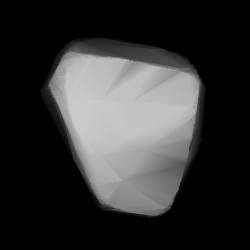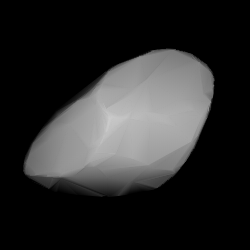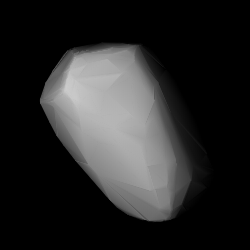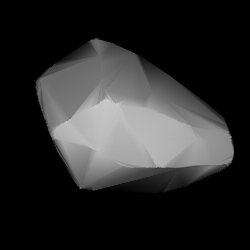Related Research Articles
716 Berkeley is a background asteroid from the central regions of the asteroid belt. It was discovered by Austrian astronomer Johann Palisa at the Vienna Observatory on 30 July 1911. The stony S-type asteroid has a rotation period of 15.6 hours and measures approximately 21 kilometers in diameter. It was named after the city of Berkeley, California, where the discoverer's colleague Armin Otto Leuschner (1868–1953) was the director of the local observatory.

748 Simeïsa is a very large Hilda asteroid from the outermost regions of the asteroid belt, approximately 104 kilometers in diameter. It was discovered on 14 March 1913, by Russian astronomer Grigory Neujmin at the Simeiz Observatory on the Crimean peninsula. The dark P-type asteroid has a rotation period of 11.9 hours and a shape that is reminiscent of a tetrahedron. It was the first asteroid discovery made in Russia and named after the discovering observatory and its nearby Crimean town, Simeiz.
751 Faïna is a very large background asteroid from the central regions of the asteroid belt, approximately 110 kilometers in diameter. It was discovered on 28 April 1913, by Russian astronomer Grigory Neujmin at the Simeiz Observatory on the Crimean peninsula. The elongated C-type asteroid (Ch) has a rotation period of 23.7 hours. It was named after Faina Mikhajlovna Neujmina, colleague and first wife of the discoverer.
779 Nina is a large background asteroid, approximately 80 kilometers in diameter, located in the central region of the asteroid belt. It was discovered on 25 January 1914, by Russian astronomer Grigory Neujmin(1886-1946) at the Simeiz Observatory on the Crimean peninsula. The metallic X-type asteroid with an intermediate albedo has a rotation period of 11.2 hours. It was named after the discoverer's sister, Nina Neujmina (Tsentilovich) (1889–1971).
789 Lena, provisional designation 1914 UU, is a metallic asteroid from the middle region of the asteroid belt, approximately 24 kilometers in diameter. It was discovered on 24 June 1914, by Soviet–Russian astronomer Grigory Neujmin at Simeiz Observatory on the Crimean peninsula, and named after the discoverer's mother.

791 Ani is a very large asteroid of the Meliboea family, located in the outer regions of the asteroid belt. It was discovered on 29 June 1914, by Russian astronomer Grigory Neujmin at the Simeiz Observatory on the Crimean peninsula. The dark carbonaceous C-type asteroid has a rotation period of 11.2 hours and measures approximately 65.7 × 103.5 kilometers, with a mean diameter of 100 km (62 mi). It was named after the historic Armenian city of Ani.

830 Petropolitana is a bright background asteroid from the outer regions of the asteroid belt. It was discovered on 25 August 1916, by Russian astronomer Grigory Neujmin at the Simeiz Observatory on the Crimean peninsula. The stony S-type asteroid has a long rotation period of 39.0 hours and measures approximately 41 kilometers in diameter. It was named after the Russian city of Saint Petersburg.
848 Inna is a carbonaceous Themistian asteroid from the outer regions of the asteroid belt. It was discovered on 5 September 1915, by astronomer Grigory Neujmin at the Simeiz Observatory on the Crimean peninsula. The C-type asteroid measures approximately 33 kilometers in diameter, while its rotation period remains unknown. It was named after Russian astronomer Inna Nikolaevna Leman-Balanovskaya (1881–1945).

882 Swetlana is a dark background asteroid from the outer region of the asteroid belt. It was discovered on 15 August 1917, by Russian astronomer Grigory Neujmin at the Simeiz Observatory on the Crimean peninsula. The X-type asteroid has a longer-than average rotation period of 29.9 hours and measures approximately 42 kilometers in diameter. The origin of the asteroid's name remains unknown.

891 Gunhild is a large background asteroid from the outer regions of the asteroid belt, that measures approximately 58 kilometers in diameter. It was discovered on 17 May 1918, by astronomer Max Wolf at the Heidelberg-Königstuhl State Observatory in southwest Germany. The dark D-type asteroid has a rotation period of 11.9 hours. Any reference of the asteroid's name to a person is unknown.

812 Adele is an elongated Eunomia asteroid from the central regions of the asteroid belt. It was discovered on 8 September 1915, by Russian astronomer Sergey Belyavsky at the Simeiz Observatory on the Crimean peninsula. The presumed S-type asteroid has a rotation period of 5.9 hours and measures approximately 13 kilometers in diameter. It was likely named after the character "Adele" in the opera Die Fledermaus by Johann Strauss.
923 Herluga is a three-body resonant background asteroid, approximately 34 kilometers in diameter, located in the central region of the asteroid belt. It was discovered on 30 September 1919, by astronomer Karl Reinmuth at the Heidelberg Observatory in southwest Germany. The carbonaceous C-type asteroid has a rotation period of 19.7 hours. It was named "Herluga", a common German female name unrelated to the discoverer's contemporaries, that was taken from the almanac Lahrer Hinkender Bote.

979 Ilsewa is a background asteroid from the outer regions of the asteroid belt, approximately 36 kilometers in diameter. It was discovered by German astronomer Karl Reinmuth at the Heidelberg-Königstuhl State Observatory on 29 June 1922. The uncommon T-type asteroid has a longer-than average rotation period of 42.6 hours. It was named after Ilse Walldorf, an acquaintance of the discoverer.

986 Amelia is a large background asteroid from the outer regions of the asteroid belt, approximately 50 kilometers in diameter. It was discovered on 19 October 1922, by Spanish astronomer Josep Comas i Solà at the Fabra Observatory in Barcelona. The L/D-type asteroid has a rotation period of 9.5 hours. It was named after the discoverer's wife, Amelia Solà.
1123 Shapleya, provisional designation 1928 ST, is a stony Florian asteroid from the inner regions of the asteroid belt, approximately 11 kilometers in diameter. It was discovered on 21 September 1928, by Russian astronomer Grigory Neujmin at Simeiz Observatory on the Crimean peninsula. It was named after American astronomer Harlow Shapley.

1129 Neujmina is an Eos asteroid from the outer regions of the asteroid belt. It was discovered on 8 August 1929, by astronomer Praskoviya Parchomenko at the Simeiz Observatory on the Crimean peninsula. The stony S-type asteroid has a rotation period of 5.1 hours and measures approximately 34 kilometers in diameter. It was named after Soviet astronomer Grigory Neujmin.

1137 Raïssa is a stony background asteroid and slow rotator, approximately 22 kilometers in diameter, located in the inner regions of the asteroid belt. It was discovered by Grigory Neujmin at Simeiz Observatory in 1929, and named in memory of Raïssa Maseeva, who worked at the Pulkovo Observatory.

1140 Crimea, provisional designation 1929 YC, is a stony asteroid from the middle region of the asteroid belt, approximately 28 kilometers in diameter. It was discovered on 30 December 1929, by Soviet astronomer Grigory Neujmin at Simeiz Observatory on the Crimean peninsula, after which it was named.

1147 Stavropolis is a stony background asteroid from the inner regions of the asteroid belt. It was discovered on 11 June 1929, by Georgian–Russian astronomer Grigory Neujmin at the Simeiz Observatory on the Crimean peninsula. The S-type asteroid has a rotation period of 5.7 hours and measures approximately 14 kilometers in diameter. It was named after the Russian city of Stavropol.

1289 Kutaïssi is a stony Koronian asteroid from the outer region of the asteroid belt. Discovered by Grigory Neujmin at Simeiz Observatory in 1933, it was later named after the Georgian city of Kutaisi. The S-type asteroid has a rotation period of 3.6 hours and measures approximately 22 kilometers in diameter.
References
- 1 2 3 4 5 "917 Lyka (A915 RR)". Minor Planet Center. Retrieved 23 February 2020.
- 1 2 3 Schmadel, Lutz D. (2007). "(917) Lyka". Dictionary of Minor Planet Names . Springer Berlin Heidelberg. p. 82. doi:10.1007/978-3-540-29925-7_918. ISBN 978-3-540-00238-3.
- 1 2 3 4 "JPL Small-Body Database Browser: 917 Lyka (A915 RR)" (2020-02-05 last obs.). Jet Propulsion Laboratory . Retrieved 23 February 2020.
- 1 2 "Asteroid 917 Lyka – Proper Elements". AstDyS-2, Asteroids – Dynamic Site. Retrieved 23 February 2020.
- 1 2 3 4 5 6 "Asteroid 917 Lyka". Small Bodies Data Ferret. Retrieved 23 February 2020.
- 1 2 3 Tedesco, E. F.; Noah, P. V.; Noah, M.; Price, S. D. (October 2004). "IRAS Minor Planet Survey V6.0". NASA Planetary Data System. 12: IRAS-A-FPA-3-RDR-IMPS-V6.0. Bibcode:2004PDSS...12.....T . Retrieved 23 February 2020.
- 1 2 3 Usui, Fumihiko; Kuroda, Daisuke; Müller, Thomas G.; Hasegawa, Sunao; Ishiguro, Masateru; Ootsubo, Takafumi; et al. (October 2011). "Asteroid Catalog Using Akari: AKARI/IRC Mid-Infrared Asteroid Survey". Publications of the Astronomical Society of Japan. 63 (5): 1117–1138. Bibcode:2011PASJ...63.1117U. doi: 10.1093/pasj/63.5.1117 . (online, AcuA catalog p. 153)
- 1 2 3 Masiero, Joseph R.; Grav, T.; Mainzer, A. K.; Nugent, C. R.; Bauer, J. M.; Stevenson, R.; et al. (August 2014). "Main-belt Asteroids with WISE/NEOWISE: Near-infrared Albedos". The Astrophysical Journal. 791 (2): 11. arXiv: 1406.6645 . Bibcode:2014ApJ...791..121M. doi:10.1088/0004-637X/791/2/121.
- 1 2 Lazzaro, D.; Angeli, C. A.; Carvano, J. M.; Mothé-Diniz, T.; Duffard, R.; Florczak, M. (November 2004). "S3OS2: the visible spectroscopic survey of 820 asteroids" (PDF). Icarus. 172 (1): 179–220. Bibcode:2004Icar..172..179L. doi:10.1016/j.icarus.2004.06.006 . Retrieved 23 February 2020.
- 1 2 Behrend, Raoul. "Asteroids and comets rotation curves – (917) Lyka". Geneva Observatory . Retrieved 23 February 2020.
- ↑ Carreño, Alfonso; Arce, Enrique; Fornas, Gonzalo; Mas, Vicente (April 2019). "Eleven Main-belt Asteroids and One Near-Earth Asteroid Lightcurves at Asteroids Observers (OBAS) - MPPD: 2017 May - 2019 Jan" (PDF). Minor Planet Bulletin. 46 (2): 200–203. Bibcode:2019MPBu...46..200C. ISSN 1052-8091.
- 1 2 "LCDB Data for (917) Lyka". Asteroid Lightcurve Database (LCDB). Retrieved 23 February 2020.